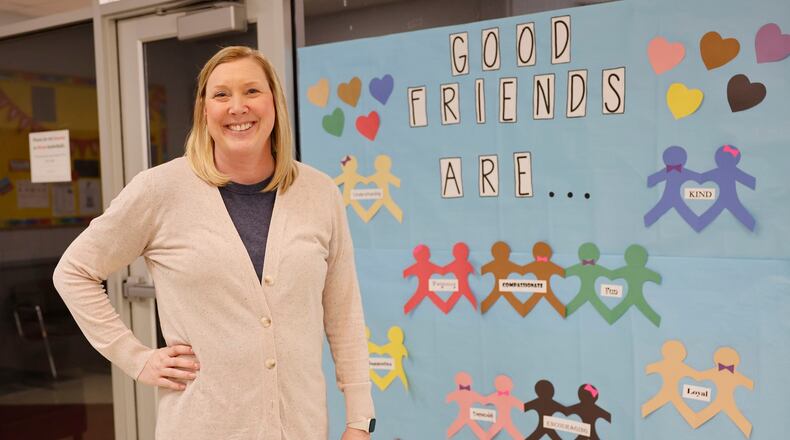And when COVID-19′s historic impact happened in March 2020 — shuttering for months all schools across Ohio and America — everything about K-12 student mental health worsened and did so fast.
A Center for Disease Control survey in 2021 showed more than a third (37%) of high school students reported they experienced poor mental health during the COVID-19 pandemic, and 44% reported they persistently felt sad or hopeless during the past year.
But the smallest of silver linings from the deadly pandemic materialized with new attention by society, government and schools focused on emotional health of K-12 students and the upheaval of their emotional lives.
And as the disruptions morphed into a rollercoaster of students forced into periodic remote learning, masking debates, class schedule gyrations and other related problems in that first two years of the virus, one constant of agreement emerged among school officials locally and nationally: Students need more mental health resources than prior to the pandemic.
More federal and state money is being used by local school systems and Miami University last month added another $1.2 million funding program to help Ohio schools, adding to its financial aid of recent years.
But the need to bolster the emotional health of students existed long before the virus.
The leader of the 10,000-student Fairfield Schools was one of the earliest voices sounding the alarm for such resources prior to the pandemic’s onset and continues to champion the cause.
“This is some of our most important work,” said Fairfield Superintendent Billy Smith.
“For us, it is all about providing as many resources and supports as possible for our students and our families,” said Smith, who oversaw an increase of school counselors.
Madison Schools Superintendent Jeff Staggs, who is in 21st year as an Ohio public school district leader, said the unprecedent onslaught by the pandemic — and the subsequent disruptions in 2021 with lingering impacts in 2022 — on students’ emotional well-being was something he had never seen before.
“Those needs were always there but I don’t think we paid quite enough attention to them to be honest,” said Staggs, who was hired as Madison’s leader in 2021 and has the longest superintendent career of all of Butler County’s district leaders.
The 1,400-student district, which is one of the smallest in Butler County, now has the first, full-time mental health specialist for students in its history.
“Covid exacerbated student mental health problems immensely. And we have devoted a lot of resources and money for students and that is something I don’t see ever going backward and I only see it increasing,” he said.
More help for student mental health and emotional well-being
And those resources — in the form of more school counselors, mental health therapists, school psychologists, partnerships with private providers and even the use of school therapy dogs — have been greatly increased in the last three years, though area school leaders are quick to argue more is needed.
And help continues to come from areas rarely seen prior to the pandemic’s onset.
Last month, Miami University announced the latest in a series of grants since the 2020-2021 school year designed to help public schools better provide mental health personnel and programs to needy students.
Miami’s “Project Aware” is co-funded by Ohio’s Department of Mental Health and Addiction Services and is using its most recent $1.2 million grant to help schools locally and statewide in its on-going assistance to improve their efforts to keep students mentally healthy.
Specifically, the grant will also help schools increase their capacity to provide mental health services and support by placing dedicated Behavioral Health and Wellness Coordinators in schools around the state, said Miami officials.
And for some schools in the Miami’s School-Based Center of Excellence (SBCOE) for Prevention & Early Intervention and the Ohio School Wellness Initiative Ohio program, its helping.
“They’re seeing an increase in students getting connected to resources and staying connected,” said Deb Robison, SBCOE Director of Outreach and Collaboration. “Schools are seeing a decrease in minor infractions, and in suspensions. School climate surveys are showing an increase in school connectedness. And we are also seeing more local partners being trained on the referral process. So if a young person comes to them expressing thoughts of self-harm or suicide, they know exactly how to get them help. All of these things are successes.”
Last year, Middletown Schools hired a veteran Lakota school principal who in recent years after leaving the district had worked with a regional organization devoted to improving youth mental health.
Suzanna Davis, director of student services for the city schools’ 6,300 students, was one of the first area school principals in the years prior to the pandemic to enthusiastically embrace the nationally acclaimed Hope Squad program for teen suicide prevention.
COVID-19 laid bare the crucial need to address the whole student’s wellbeing beyond academics, she said, adding “these needs have continued to rise due to the overwhelming impact of COVID.
You can’t expect students to learn if they are battling significant mental health challenges, said Davis, whose district — prompted by COVID-19 — has seen for the first-time student counselors hired for all 10 Middletown schools.
“The mental health of our students is the foundation for their educational experience and can be an extreme barrier to learning if not appropriately identified and supported,” said Davis.
“If we don’t envelope our students with positive mental health supports, we have missed a critical opportunity to advance their overall wellbeing.”
Monroe Superintendent Robert Buskirk said his 2,900-student district has joined others locally in the last three years in marshalling more resources to address student needs.
Since March 2020, Monroe has added two guidance counselors, which also work as liaisons for contracted youth mental health services, one each at the elementary and secondary level grades.
Also, an additional social worker has been added, said Buskirk and the district’s two schools now also provide meeting space for a private, mental health care company to meet with student clients and their families.
It’s progress, but more is needed, he said.
“With the pandemic, it didn’t create new behaviors or scenarios (of student misconduct and challenges) but it made them more prominent.”
Covid-prompted disruptions in the development of students since 2020 persist “and we’re definitely still seeing the effect of that,” said Buskirk.
Not all local districts have been able to ramp up resources.
Edgewood Schools, which will be asking residents to approve the first school earned income tax hike in the district’s history in the May election, has fewer personnel focus on student mental health due to cost restraints forced by projected budget deficits, said district officials.
While school counselors in Edgewood have increased from six in the 2020-2021 school year to seven this school year, the district has lost two “social and emotional coordinators” during the same period and five part-time mental health therapists who provided student and family mental health therapy.
Fairfield North Elementary School Counselor Laura Monnier was and remains on the front lines of the emotional health battle pre and post-pandemic.
“We’re now playing catch up with our kids … in meeting all their needs,” said the 20-year veteran of Fairfield Schools, which added counselors in each of its six elementary schools since virus’ onset.
The time forced away from schools and the lack of in-person, social interaction development during the pandemic’s numerous disruptions in 2020 and 2021 have produced “anxiety” among some students said Monnier.
“They have had a harder time of adjusting to being at school full time,” Monnier.
She, however, remains mostly upbeat.
“We are continuing to build from a new foundation and continuing to improve and add things so I’m really optimistic but I also see a lot of needs in the future.”
About the Author

